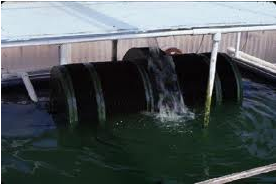Practitioner's Tool / Rotating Biological Contactors
Rotating biological contactor (RBC), or biodisc, technology is a fixed-film aerobic treatment process that can be very effective in treating a variety of wastewaters. It is a secondary treatment process, meaning that grit removal and primary settling are required before the RBC process.
The RBC is composed of a plastic or composite material specifically fabricated to maximize surface area. The material is in the shape of a disc that rotates around a steel shaft. The disc is partially submerged in the trough where it contacts the primary effluent to be treated. After an initial startup period, the disc becomes populated with microorganisms that feed on the organic material in the wastewater. As the disc rotates first through the wastewater and then through the atmosphere, the microbes become oxygenated. The RBC, therefore, is an aerobic treatment process that achieves aeration mechanically rather than through blowers or aerators. RBCs can achieve the same level of aeration as an activated sludge plant at a fraction of the power consumption.
After many years of improvements, RBC technology has become very reliable. In the past, failure of the steel shaft was the major limitation with this technology. Now, with better construction and lighter disc material, shaft failure is infrequent. Still, when fully loaded with a mature crop of microbes, the wetted disc can be very heavy. For optimal operation, it is most important that once started, the disc remain in motion. Power failures that result in the disc stopping for an extended period of time may result in settling and uneven weight distribution. Then, when the disc starts again, a wobble can create stresses on the mechanism. Therefore, RBCs are frequently supported by generators that ensure a constant power supply to the mechanism.
There are a number of commercial manufacturers of biodiscs, many which support their products with extended warranties of up to 20 years. Review the material below for more information on this technology.
The Environmental Protection Agency's Design Criteria for RBCs

